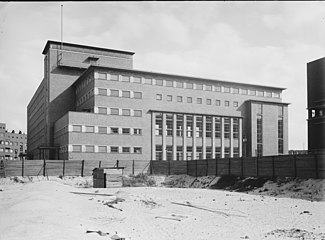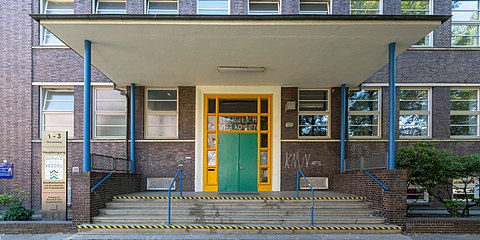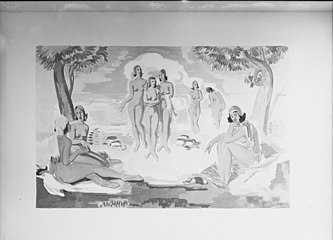School on the Veddel
| School on the Veddel | |
|---|---|

|
|
| Rear view | |
| type of school | District school |
| founding | 1932 |
| address |
Sloman ascent 1–3 |
| place | Hamburg-Veddel |
| country | Hamburg |
| Country | Germany |
| Coordinates | 53 ° 31 '37 " N , 10 ° 1' 10" E |
| student | 508 (school year 2020/21) |
| management | Bianka Petri |
| Website | schule-auf-der-veddel.hamburg.de |
The school on the Veddel is a district school in the Hamburg district of Veddel . It is the only school in this part of the city, which is quite isolated by the Elbe, canals and port facilities. The school on the Veddel has its own primary level and a lower secondary level and can therefore be attended from pre-school to 10th grade. The school was founded in 1932, the design for the school building, which is now a listed building, comes from Fritz Schumacher . Since it was founded, the school was called Schule Slomanstieg after its address , according to the type of school first elementary school Slomanstieg , thenElementary, secondary and secondary school Slomanstieg . As of 2010, the school was converted into a district school as part of the Hamburg school reform and renamed after its district.
story
Planning for the Slomanstieg School began in 1912, but construction based on plans by Fritz Schumacher did not begin until 1929. The school was inaugurated in 1932, and 1932 is the year it was founded. The first pupils came from the school on Sieldeich or the school Slomanstrasse 58; both buildings no longer exist. The newly built school had a large auditorium (which can also be used as a cinema), various sports facilities, a public book hall and a dental clinic . This meant that the Slomanstieg School should also become a cultural center for the workers' settlement on the Veddel.
At the beginning of the 1935/36 school year, Hinrich von der Lieth (1900–1951) was appointed headmaster of the Slomanstieg School. He had been a member of the NSDAP since 1930 and was therefore an “ old fighter ” and chairman of the Hamburg National Socialist Teachers' Association (NSLB). In mid-November 1935 an advertising campaign for the Hitler Youth (HJ) took place in the school . It was announced that at that time 90% of the students at the Slomanstieg school were HJ members, twice as many as at other Hamburg schools. It was not until December 1936 that membership in the Hitler Youth became compulsory. In 1939 a joint superstructure was set up for the separate schools for boys and girls; at the school one could now acquire the secondary school leaving certificate.
After the war, the Slomanstieg School was a primary, secondary and secondary school. In 1956, co-education was introduced and boys 'and girls' schools were united. The cinema in the school ( Lichtburg Veddel ) had 550 seats and used the auditorium as an "alternative theater ". The cinema was equipped with Cinemascope from 1958 and existed until the early 1960s. In 2003 the NDR produced a documentary about everyday life at the school, about which there was controversy. According to Joachim Schroeder , the film painted the “picture of irreconcilable contrasts between Muslim immigrants and helpless Germans”, although the school is not an example of a “run-down ghetto school”, on the contrary, it is the cultural center of the district.
With the Hamburg school reform , the elementary, secondary and secondary school Slomanstieg was converted into a pure elementary school Slomanstieg in 2010 . In 2012 the school was rebuilt as a district school with an attached elementary school, using its school buildings. Between 2012 and 2014 the school Slomanstieg was renamed School on the Veddel .
In the course of the COVID-19 pandemic , a total of 550 students and employees of the school were tested in November 2020. 94 infections were found, 32 of them in teachers. With 74 tested teachers, this corresponded to a positive rate of 43%. The school on the Veddel was then closed and lessons were only carried out at a distance .
Location and architecture
The school grounds are between Wilhelmsburger Strasse in the west and Slomanstrasse in the east. To the north there is the sloman ascent and a small square that opens up a view of the facade of the north wing. To the south, the two wings of the structure encompass the school yard, which is followed by a sports field. The school grounds are a good 5,000 m², including the sports facility, it is around 16,000 m².
The building consists of three connected cubic building structures with a flat roof. The simple and flat facades are provided with dark clinker brick and light-colored ribbon windows. The five-story main building is oriented to the north, the three-story east wing houses a school and district library on the ground floor, and the cafeteria is in the basement. The east wing with the library ends in a loggia that is open on three sides and is built over two floors. The gymnasium, auditorium and gymnastics room are integrated in the west wing of the building and can only be recognized by the window fronts, as was the case with most of Schumacher's school buildings.
The school building is a typical example of the Hamburg elementary school building program of the late 1920s. With 38 classrooms, the school was the largest primary school building project in Hamburg before the Second World War. The school buildings at Slomanstieg 1 and 3, at Slomanstrasse 10 and 12, at Wilhelmsburger Strasse 15, including their fittings and enclosures, are listed as historical monuments. A mural by Otto Thämer in the gymnastics hall is one of the protected features . In the school there were other works that were created as part of the Wall Pictures in Hamburg State Buildings program, including wall pictures by Paul Kayser and Eduard Hopf in the hallways and by Eduard Kasper and Arnold Fiedler in the teachers' rooms. In the loggia by the library there was a large, octagonal bench made of granite , on which a stele with a brass gull by Ludwig Kunstmann is attached in the middle .
Building jewelry: Hamburg coat of arms
Mural by Eduard Hopf : "Nudes outdoors" (not preserved)
Mural by Paul Kayser : "Elbe near Cuxhaven"
Granite bench with seagull by Ludwig Kunstmann
School profile
The school on the Veddel is a partially linked all - day school . The school teaches from grade 1 to grade 10 ( secondary level I ), so it is a long-form district school without its own upper level. In 2020, grades 1 to 4 were run in three to four classes, from class 5 onwards only in two classes. According to plans by the Hamburg school authorities , the school is to be run in the primary school area only in 2.5 times by 2030, and in two times in the district school area from grade 5 onwards.
The catchment area of the school is relatively small compared to other district schools in Hamburg. Half of the school's students come from the Veddel district . Since the Elbe island Veddel is only inhabited on the tip west of the federal highway 255 , these students live in the direct vicinity of the school. The majority of the remaining students come from the northern part of Wilhelmsburg , a few also from Rothenburgsort . In the eight school years from 2000/2001 to 2007/2008, 130 pupils left school with a secondary school certificate, 93 pupils (41%) were dismissed without a school certificate. When the social index for Hamburg schools was surveyed in 2011, a social index of 1 was calculated for the school on the Veddel. The scale ranges from 1 (disadvantageous requirements of the student body, highest need for support) to 6 (best conditions, no need for support). In the 2016/17 school year, a good 90% of the students at the school on the Veddel had a migration background , almost twice as much as the average of all Hamburg district schools .
The school has a career orientation concept and has been working with the neighboring Norddeutsche Affinerie (now Aurubis) since 2006 to integrate student internships and preparation for vocational training into the school operations. Aurubis AG calls the school on the Veddel a “partner school”. Aurubis offers the “AV10-Plus” model, in which students are introduced to training maturity in various professional areas three days a week. On the other two days of the week, they continue to attend school. From 2007 to 2015, 100 pupils from the school on the Veddel completed the project. 88% of the graduates who completed the internship with the exam then received an apprenticeship contract with Aurubis Hamburg.
literature
- 75 years of the Slomanstieg School: 1932–2007 . Hamburg 2007, PPN 534234852 .
- Primary school on the Veddel . In: Bauwelt , ISSN 0005-6855 , year 20 (1929), supplement to issue 47, p. 6.
- Primary school on the Veddel . In: Deutsche Bauzeitung , ISSN 0721-1902 , volume 67 (1933), p. 127.
Web links
Individual evidence
- ↑ a b c Authority for Schools and Vocational Education and Training together with the Institute for Educational Monitoring and Quality Development : SISy - School Info System Hamburg , entry for the school on the Veddel. (Accessed December 2020)
- ^ Boris Meyn : The history of the development of the Hamburg school building . Hamburg 1998, p. 534. (inventory number 181)
- ↑ 75 years of the Slomanstieg School: 1932–2007 . Hamburg 2007.
- ↑ The school on Sieldeich had the address Sieldeich 28, and existed from 1869 to 1932. ( Establishment of the school on Sieldeich, 1869–1932 , holdings in the Hamburg State Archives (call number 311-2 IV_DV VD 9 a II Bu 2 a)
- ↑ According to Uwe Schmidt ( Hamburg Schools in the “Third Reich” , Volume 2, Hamburg 2010, doi : 10.15460 // HUP / BGH.64.101 , p. 829) the school Slomanstraße 58 was founded in 1898, and in 1939 boys and girls were still there Coeducation taught. After 1945 the school was given up.
- ↑ a b c d 277 Veddel elementary school at the Fritz Schumacher Society (archive version 2019)
- ↑ a b A school as a lifeline for an entire neighborhood . In: Welt , April 4, 2007.
- ↑ Hans-Peter de Lorent : Hinrich von der Lieth . In: State Center for Civic Education Hamburg (ed.): Topography of those who were NS in Hamburg (database)
- ↑ Anna Lambert: The vocational training in the National Socialism in Hamburg (= Volume 43 of vocational training, work and innovation - dissertations and habilitations). Bertelsmann, Bielefeld 2017, ISBN 978-3-7639-5809-2 , pp. 206-208.
- ^ Law on the Hitler Youth , Reichsgesetzblatt 1936, p. 993
- ^ A b Uwe Schmidt: Hamburg Schools in the "Third Reich" , Volume 2 (Appendix: Directory of schools from 1933 to 1945 ). Hamburg 2010, p. 829. ( doi : 10.15460 // HUP / BGH.64.101 )
- ↑ Lichtburg Veddel at the Association of Film and TV Museum Hamburg e. V.
- ^ Dieter Thal: Hamburg-Veddel . Sutton, Erfurt 2012, ISBN 978-3-95400-111-8 , p. 70.
- ↑ Nix German - A school fights for integration . First broadcast on January 13, 2004 on NDR.
- ↑ Joachim Schroeder : When schools (want to) use diversity . In: Wolf-Dietrich Bukow, Gerda Heck, Erika Schulze, Erol Yildiz (eds.): New diversity in urban urban society . VS Verlag für Sozialwissenschaften, Wiesbaden 2011, ISBN 978-3-531-93082-4 , p. 93 f.
- ↑ Ordinance on measures within the framework of school organization at the beginning of the 2010/2011 school year from October 7, 2010. In: Hamburgisches Gesetz- und Verordnungsblatt (HmbGVBl), 2010, p. 561 ff.
- ↑ Ordinance on measures within the framework of school organization at the beginning of the 2012/2013 school year of July 17, 2012. In: Hamburgisches Gesetz- und Verordnungsblatt (HmbGVBl), 2012, p. 348 ff.
- ↑ dpa / lno: Almost 100 corona infections at school in Hamburg-Veddel . In: Süddeutsche Zeitung, November 20, 2020.
- ↑ Jens Meyer-Wellmann: 94 infections at Hamburg school - now distance teaching . In: Hamburger Abendblatt, November 21, 2020.
- ↑ Two Hamburg schools close, the Ida Ehre school opens . In: NDR, November 20, 2020.
- ↑ a b Ralf Lange : Architectural Guide Hamburg . Edition Menges, Stuttgart 1995, p. 282. (Entry L 2.2)
- ^ Authority for Culture and Media, Monument Protection Office (ed.): List of monuments of the Free and Hanseatic City of Hamburg , as of November 11, 2019, p. 4377. (Monument ID 13033)
- ↑ Free and Hanseatic City of Hamburg, Authority for Schools and Vocational Education and Training (Ed.): School development plan for state primary schools, district schools and high schools in Hamburg 2019 . Hamburg, September 24, 2019, p. 31 (final version, online )
- ↑ a b Authority for School and Vocational Education and Training together with the Institute for Educational Monitoring and Quality Development : Hamburg Education Atlas , information on the school on the Veddel, school year 2017/18.
- ↑ District Office Hamburg-Mitte , Specialist Office Social Space Management: Social Space Description Veddel, Kleiner Grasbrook, Steinwerder , Hamburg 2010, p. 21. (Section 3.10, "School leaving certificates")
- ↑ Small written question from MP Robert Heinemann (CDU) of February 28, 2013 and answer from the Senate. Citizenship of the Free and Hanseatic City of Hamburg - 20th electoral term, printed matter 20/7094 , Annex 4b: Old and new social indices of the state secondary schools, p. 27.
- ↑ Peter Ulrich Meyer: That's how high the proportion of migrants in Hamburg schools is . In: Hamburger Abendblatt from April 19, 2018 (at the Hamburg district schools, the average was 48%)
- ↑ District Office Hamburg-Mitte , Specialist Office Social Space Management: Social Space Description Veddel, Kleiner Grasbrook, Steinwerder , Hamburg 2010, p. 27 f. (Section 4.4, "School")
- ^ Friederike Grupe: Hamburg-Veddel - a German secondary school . In: Hamburger Abendblatt, April 8, 2006.
- ↑ School on the Veddel on the Aurubis AG website (accessed December 2020)
- ^ Start of apprenticeship at Aurubis , Aurubis AG press release of September 4, 2015.







